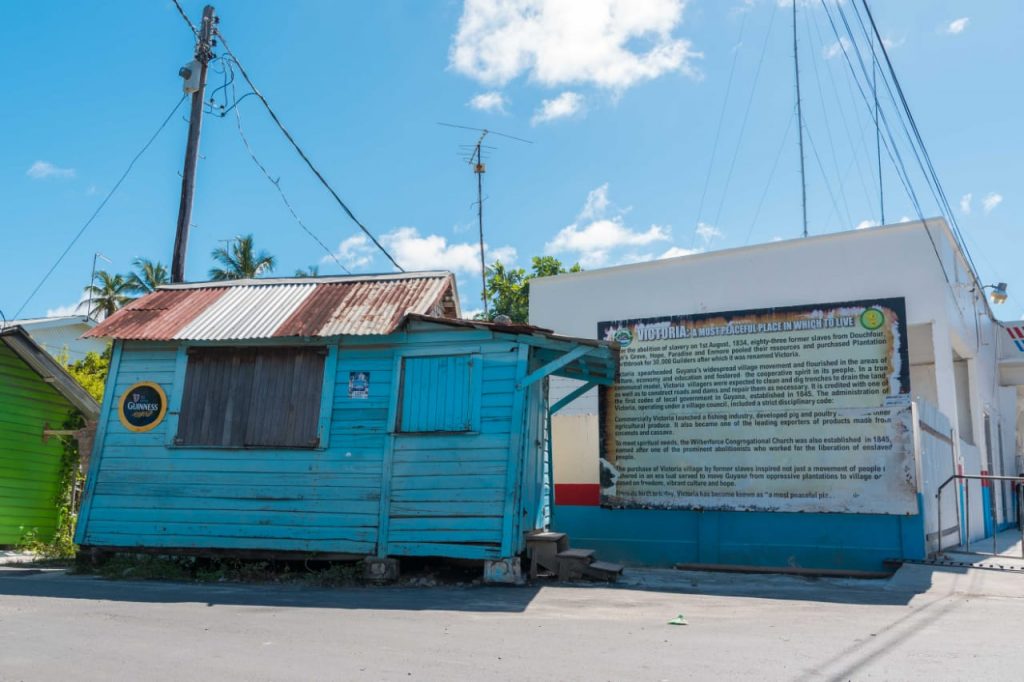From Northbrook to Victoria- holding steadfast to her African heritage amid transformation
(Department of Public Information) – Their dance moves are bold and their skills are daunting to those who they approach. Wild yet composed and smooth on their feet, wherever they go they capture complete awe and smiles on the faces of on-lookers.
The Victoria Renegades continue to uphold the masquerade culture of their ancestors bringing alive characters consistent with African masquerade culture such as the mad cow/mad bull, bam-bam sally and the stilt man.
They hail from Victoria on the East Coast of Demerara, the first land bought by the Emancipated Africans of Guyana and are just an example of the rich African culture preserved in the village today.
Bordered by Belfield on the east and Cove and John towards the west, Victoria is referred as the ‘Mother of all villages’ as it was the first community to be established in then British Guiana and signalled a widespread effort called the village movement.

The village, formerly called Northbrook, was bought on November 7th, 1839 one year after emancipation on August 1st, 1838 by eighty-three ex-slaves from the estates of Douchfour, Ann’s Grove, Hope, Paradise and Enmore.
At the entrance of the village, just off the gas station, is a historic wooden structure called the Emancipation Hut, still standing today, where the slaves were said to have queued during the apprenticeship period (1834-1838) to receive their wages.

DPI met up with the oldest resident of the village who took us more than ninety years back in time.
Bent by years of hard work, the lines embedded on her face and hands tell of her lengthy life, though her remarkable memory and strong voice showcases her evident youthfulness.
Now ninety-nine and more than half the age of the village, Mrs. Evelyn Bacchus moved to the Victoria in 1926 when she was four. Her father was born in Victoria and was the grandson to one of the freed slaves who pooled money to buy the village.

She told stories of drinking water from the nearby trench and going to school in mud because of the state of the dams.
“You go to school in mud and you coming back in mud,” she recalled and also mentioned that they went to school barefooted.
“We don’t know anything about shoes and socks going to school. Today the children got it good, they want shoes and socks and taxi come home for them.”
Bacchus also share that the main occupation of the village was producing coconut oil, cassareep and poultry.

Today the village is more developed, with paved roads, better schools and electricity and potable water among other amenities. Victoria has one primary school, two nursery schools and a recent training school established by village stalwart, Desmond Saul.
Farming is still a major activity in the village and the production of cassava products is still somewhat lively. Directly on the line is Major’s Food and on the western side-line is Moses’ Cassava Bread Factory both of which produce a variety of cassava products.

The village has eighteen churches, which reflects the importance of spirituality in the lives of the Africans.
One of the first buildings erected in the village was the Wilberforce Congregational Church, built in 1845.
The old wooden structure is today rebuilt into a stout concrete structure, bearing much resemblance to the old structure.
Although much has changed from the time Evelyn Bacchus grew up, the rich African cultural heritage and traditions in Victoria today are unmatched as the villagers continue to hold steadfast to the things held dearest to their ancestors.
(Text by Akeasha Boodie. Photos by Ameer Sattaur)







